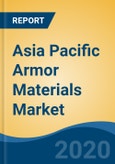Free Webex Call
The Asia-Pacific Armor Materials Market is expected to grow at a substantial rate during the forecast period. The growth of this market can be accredited to growing incidences of armed conflicts, instances of terrorism and rising tension between neighbouring countries in the region. The Asia-Pacific has been identified as a high-potential market for armored materials on account of increasing asymmetric warfare activities in the region. Moreover, the development of advanced weapons coupled with increased homeland security concerns are some of the other major reasons responsible for the growth of the Asia-Pacific Armor Materials Market. Along with this, modernization of military programs across various countries in the region is ensuing the high demand for armors, which is estimated to bolster the market growth over the next 5 years. However, high production cost of defence products can act as major restraining factor in the growth of the Asia-Pacific Armor Materials Market through 2025.Speak directly to the analyst to clarify any post sales queries you may have.
10% Free customizationThis report comes with 10% free customization, enabling you to add data that meets your specific business needs.
The Asia-Pacific Armor Materials Market is segmented based on type, application, region and company. By type, the market is categorized into metals & alloys, ceramics, composites, para-aramid fibers, ultra-high-molecular-weight polyethylene (UHMWPE) and fiberglass. Among them, the ceramics category dominated the market until 2019 and is anticipated to witness robust CAGR in terms of both value and volume during the forecast period. This high growth can be attributed to its low weight and high rigidity. Additionally, ceramics are widely used in armor vehicles, aerospace, and body armor applications, as these products have controlled micro-structures, which ensures better performance and durability, thereby driving the segment growth in the region.
Major players in the Asia-Pacific armor materials include DuPont de Nemours, Inc, Koninklijke DSM N.V., Honeywell International Inc., 3M Company, Saab AB, Koninklijke Ten Cate BV, Armor Designs Inc., Armorsource LLC, JPS Composite Materials, PPG Industries Inc and others. The key players operating in the market are rapidly adopting various strategies in order to expand their geographic reach.
Years considered for this report:
- Historical Years: 2015-2018
- Base Year: 2019
- Estimated Year: 2020
- Forecast Period: 2021–2025
Objective of the Study:
- To analyse and forecast the market size of the Asia-Pacific Armor Materials Market.
- To forecast the Asia-Pacific Armor Materials Market based on type, application and regional distribution.
- To identify drivers and challenges for the Asia-Pacific Armor Materials Market.
- To examine competitive developments such as expansions, new product launches, mergers & acquisitions etc. in the Asia-Pacific Armor Materials Market.
- To conduct the pricing analysis for the Asia-Pacific Armor Materials Market.
- To identify and analyse the profile of leading players operating in the Asia-Pacific Armor Materials Market.
The author performed both primary as well as exhaustive secondary research for this study. Initially, they sourced a list of armor materials manufacturers across the region. Subsequently, they conducted primary research surveys with the identified companies. While interviewing, the respondents were also enquired about their competitors. Through this technique, they could include the suppliers which could not be identified due to the limitations of secondary research. The author analyzed the product types, application types and presence of all major armor materials manufacturers across the region.
The author calculated the Asia-Pacific Armor Materials Market size by using a bottom-up approach, where data for various end-user industries and its application across various product types were recorded and forecast for the future years. They sourced these values from the industry experts and company representatives and externally validated through analyzing historical data of these product types and applications for getting an appropriate, overall market size. Various secondary sources such as company websites, news articles, press releases, company annual reports, investor presentations and financial reports were also used.
Key Target Audience:
- Armor materials manufacturers, suppliers, distributors and other stakeholders
- Government bodies such as regulating authorities and policy makers
- Organizations, industrial associations, forums and alliances related to armor materials
- Market research and consulting firms
The study is useful in providing answers to several critical questions that are important for the industry stakeholders such as armor materials manufacturers, end-users etc., besides allowing them in strategizing investments and capitalizing on the market opportunities.
Report Scope:
In this report, the Asia-Pacific Armor Materials Market has been segmented into following categories, in addition to the industry trends which have also been detailed below:
- Market, By Type:
- Metals & Alloys
- Ceramics
- Composites
- Para-Aramid Fibers
- Ultra-high-molecular-weight Polyethylene
- Fiberglass
Market, By Application:
- Vehicle
- Aerospace
- Body
- Civil
- Marine
Market, By Country:
- China
- India
- Japan
- Australia
- South Korea
Competitive Landscape:
- Company Profiles: Detailed analysis of the major companies present in the Asia-Pacific Armor Materials Market.
Available Customizations:
With the given market data, the author offers customizations according to a client’s specific needs.
Table of Contents
1. Product Overview2. Research Methodology3. Executive Summary4. Voice of Customer5. Global Armor Materials Market Overview8. Market Trends & Developments10. Strategic Recommendations11. About Us & Disclaimer
6. Asia-Pacific Armor Materials Market Outlook
7. Market Dynamics
9. Competitive Landscape
Companies Mentioned (Partial List)
A selection of companies mentioned in this report includes, but is not limited to:
- DuPont de Nemours, Inc
- Koninklijke DSM N.V.
- Honeywell International Inc.
- 3M Company
- Saab AB
- Koninklijke Ten Cate BV
- Armor Designs Inc.
- Armorsource LLC
- JPS Composite Materials
- PPG Industries Inc.








